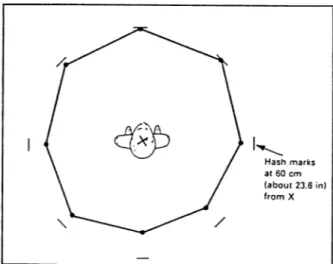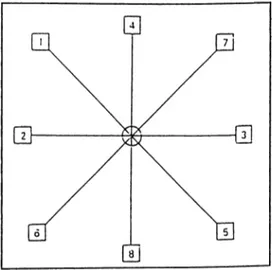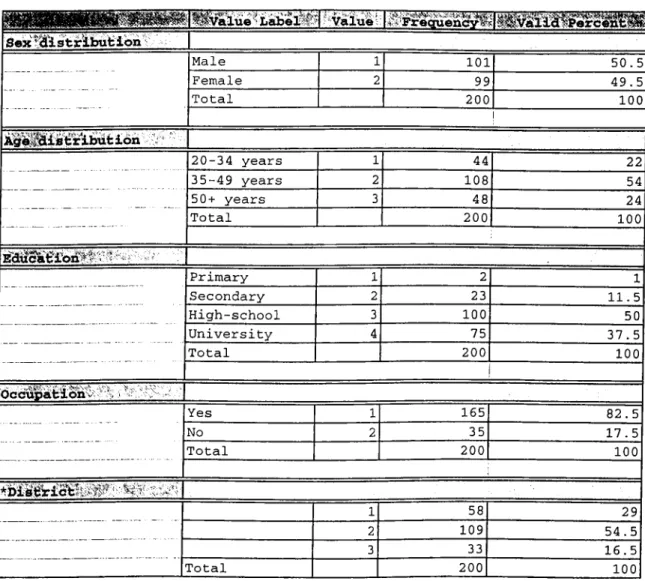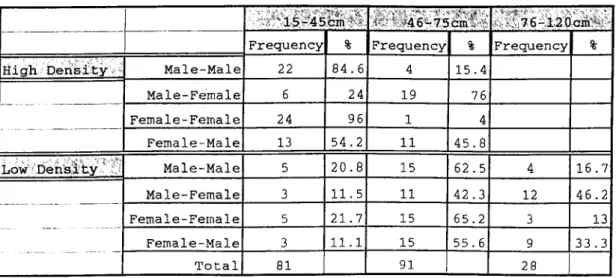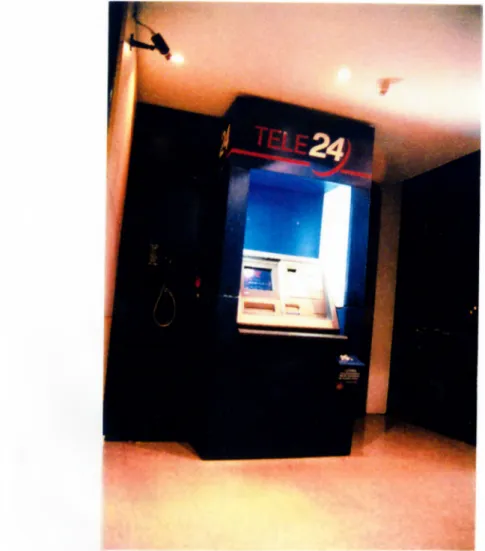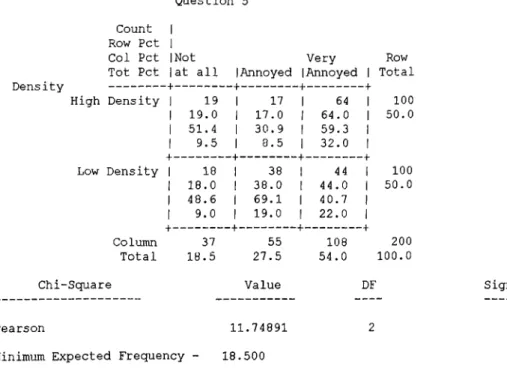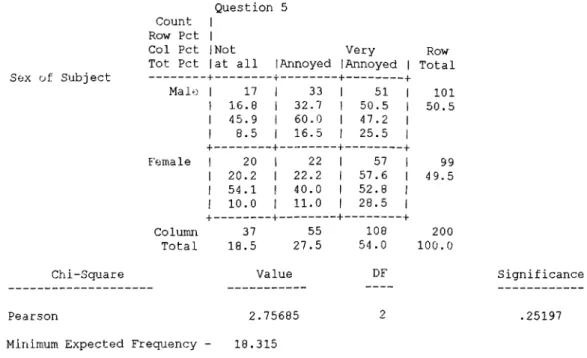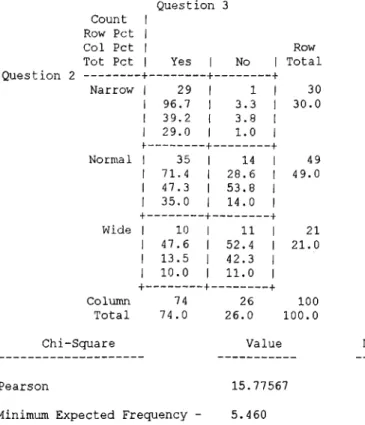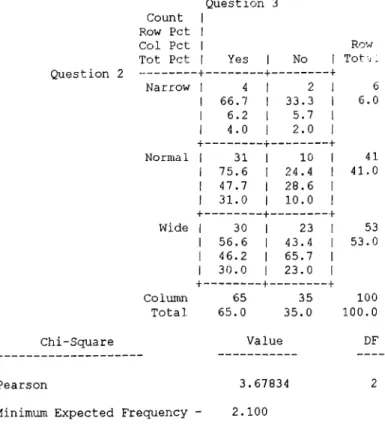Т1|Г
№ i l î Ш в i l i · ' Ü il I k ü -я ■ ■fli: ^ и а іІТ Ѵ Т Г іІіІ p p jriip jp o iiß ' îflP
4 * > * Г “» к й і 'll i W Ä i« i'tl l i t a » * ж w i l l « l İ ^ .Îİ І І ¥ ' s b i i ' У ı» ΙΛ Λ 3 W ' î i S İ ‘4'
i i i i ? i ! i i4
á f!İt?:g й:У k M ііІПГйіімТіг? • ' î f İ l l â P M l I l Ç#
*
Ί
ΐ
f
c
)
I
Ú
W
ü» O y
·
W 5
«
t
^
“
- ’
ΐ^ΐ·*·« яРііЗІ«
!
#
i
i
i
i
^
i
»
-
-
S
^
ï
м « « ;
1
ш
*
лім!
y
t
»
¡
¿
Ι
ί
*
!
ϊ
à i’
i
î
h
}
'
.
»
i
f
c
W
J
*'İf*,iU -î j S*i. 2 ‘.C i i * ! t f i " * i» 'ii .М .П ІЙ ,1 Д ‘isAbi* lÜ Ü ' 4 '•йь.Д ..•■’“ î. Г “:: î' !· î :■;“* i n î r.
1w «V ;» ,î«w*· ’’S ii - î î ^ Ü1iü;
Λ ». · * ιΑ4<»4 4* ’ . Âi » : ш- ·*Η,»Ι·
THE EFFECTS OF SHORT-TEPM CROWDING ON PERSONAL SPACE:
A CASE STUDY ON A N AUTOMATIC TELLER MACHINE
A THESIS
SUBMITTED TO THE DEPARTMENT OF
INTERIOR ARCHITECTURE AND ENVIRONMENTAL DESIGN
AND THE INSTITUTE OF FINE ARTS
OF BiLKENT UNIVERSITY
IN PARTIAL FULFILLMENT OF THE REQUIREMENTS
FOR THE DEGREE OF MASTER OF FINE ARTS
Naa. Kayo..
By
Naz Kaya
June, 1997
И И
Ι ί ? 1
■ К 2 . 3I certify that I have read this thesis and that in my opinion it is fully adequate, in scope and in quality, as a thesis for the degree of Master of Fine Arts.
Assist. Prof. Dr. Feyzan Erkip (Supervisor)
I certify that I have read this thesis and that in my opinion it is fully adequate, in scope and in quality, as a thesis for the degree of Master of Fine Arts.
I certify that I have read this thesis and that in my opinion it is fully adequate, in scope and in quality, as a thesis for the degree of Master of Fine Arts.
Approved by the Institute of Fine Arts
ABSTRACT
THE EFFECTS OF SHORT-TERM CROWDING ON PERSONAL SPACE
A CASE STUDY ON AN AUTOMATIC TELLER MACHINE
Naz Kaya
M.F.A. in Interior Architecture and Environmental Design Supervisor: Assist. Prof. Dr. Feyzan Erkip
June, 1997
The aim of this study is to put forth the effects of short term crowding on personal space. The analysis is planned to be carried out by means of a research on Automatic Teller Machine (ATM) users in Ankara. Initially, the conceptions and definitions of personal space and crowding are defined. The influences of crowding on personal space are discussed under the headings of personal space intrusion, withdrawal
behaviors, and privacy reduction. The activity, withdrawing money from an ATM requires certain privacy needs which may vary with personal characteristics of the individuals. Among these, sex differences are considered as an important factor. In order to search for the effects of high density on
interpersonal distance, two levels of density, low and high, are considered. The survey is carried out through observation and short interviews with the users in both density
conditions. Finally, the clues about mismatches between space characteristics and user expectations are obtained through this study. Based on the findings of this survey as well as the literature review, appropriate design solutions for an indoor ATM hall are developed.
Keywords:
Personal Space, Crowding, Automatic Teller Machine (ATM), Personal Space Intrusion, Density.ÖZET
KISA SÜRELİ KALABALIKLIĞIN KİŞİSEL ALANA ETKİLERİ
BANKAMATİK ÜZERİNE BİR ÇALIŞMA
Naz Kaya
İç Mimarlık ve Çevre Tasarımı Bölümü Yüksek Lisans
Tez Yöneticisi: Yrd. Doç. Dr. Feyzan Erkip Haziran 1997
Bu tezin amacı, kısa süreli kalabalıklığın kişisel alan üzerine etkilerini ortaya koymaktır. Bunun için Ankara'da bankamatik kullanıcılarını kapsayan bir araştırma
yapılmıştır. Önce, kişisel alan ve kalabalıklıkla ilgili kavramlar ve tanımlar belirtilmiştir. Kalabalıklığın kişisel alana etkileri ise, kişisel alan istilası, insanların
davranışları ile gösterdikleri tepkiler ve mahremiyetin azalması başlıkları altında tartışılmıştır. Bankamatikte işlem yapanların kişisel özelliklerine göre, mahremiyet ihtiyaçları farklılık göstermiştir. Bu özellikler arasında cinsiyet farklılıkları önemli bir unsur olarak sayılabilir. Bu çalışmada, yoğunluğun, kuyrukta bekleyen kişiler
arasındaki uzaklıklar üzerindeki etkilerini araştırmak için, düşük ve yüksek olmak üzere iki tip yoğunluk durumu göz önünde tutulmuştur. Bu amaçla, bankamatik kullanıcıları
gözlemlenmiş ve onlarla kısa görüşmeler yapılmıştır. Sonuçta, mekan özellikleri ve kullanıcı beklentileri arasındaki
uyumsuzluklar hakkında ipuçları elde edilmiştir. Bu
araştırmanın sonuçlarına ve literatür taramasına dayanarak, iç mekanlardaki bankamatik alanları için uygun tasarım çözümleri geliştirilmiştir.
Anahtar Sözcükler:
Kişisel Alan, Kalabalıklık, Bankamatik, Kişisel Alan İstilası, Yoğunluk.I would like to thank, first of all, my supervisor Assist. Prof. Dr. Feyzan Erkip for her support and guidance
throughout the study. I would never be able to complete this work without her patient supervision and constant
encouragement.
In addition, I would like to send my special thanks to my family for being so thoughtful and wish to express my thanks to my grandmother. Şükran Günsoy, for her invaluable support.
ACKNOWLEDGEMENTS
Special thanks to all of my friends for their help and
friendship. Finally, I would like to thank all the ones who have helped me and given me critics about this study.
SIGNATURE PAGE... Ü
ABSTRACT... iii
ÖZET...iv
ACKNOWLEDGEMENTS... .
TABLE OF CONTENTS... vi
LIST
OF TABLES... ix
LIST
OF FIGURES... x
1. INTRODUCTION... 1
2. PERSONAL SPACE... 5
2.1. Definition and Conceptions of Personal Space...
5
2.1.1. The Functions of Personal Space... 9
2.1.2. Proxemics... 11
2.2. Factors Influencing Personal Space... 13
2.2.1. Individual Differences... 14 2.2.2. Situational Variables... 16 2.2.2.1. Social Situation... 16 2.2.2.2. Physical Situation... 17 2.2.3. Cultural Variations... 22
TABLE OF CONTENTS
VI2.3. Measurement Techniques for Personal Space... 24
2.3.1. Simulation Method... 25
2.3.2. The Stop-distance Method... 26
2.3.3. Observational Method... 27
3. CROWDING...2 9
3.1. Definition and Conceptions of Crowding... 2 9 3.2. Factors Influencing Crowding... 343.2.1. Personal Factors... 34
3.2.2. Social Interaction... 36
3.2.3. Cultural Factors... 38
3.2.4. Physical Factors... 39
3.3. Influences of Crowding on Personal Space... 41
3.3.1. Personal Space Intrusion... 42
3.3.2. Privacy Reduction... 44
3.3.3. Withdrawal Behaviors... 44
3.4. Crowding Theories in Relation to Personal Space.46 3.4.1. Sensory Overload Theory... 46
3.4.2. Personal Control Theory... 47
3.4.3. Arousal Theory... 4 9 3.4.4. Behavioral Constraint Theory... 49
4. THE EFFECTS OF SHORT-TERM CROWDING ON PERSONAL SPACE:
A CASE STUDY ON AN AUTOMATIC TELLER MACHINE
... 514.1. Methodology of the Study... 51
4.1.2. Sampling... 53
4.1.3. Research Methods and Procedure...54
4.1.4. Hypotheses... 55
4.2. Analysis and Results of the Study... 57
4.3. Discussion and Design Recommendations... 65
5.
CONCLUSION... 72
REFERENCES... 76
APPENDICES
APPENDIX A
Views from ATM hall... 86APPENDIX B
Observation Form... 88APPENDIX C
Questionnaire Form... 89Table 1. Characteristics of Sample Group... 58
Table 2. The Relation between Sex Pairings and Distances... 64
Table D.l. Density by Distance... 90
Table D.2. Density by Question 5 ... 90
Table D.3. Sex of Subject by Question 5 ... 91
Table D.4. Sex of Subject by Question 6 ...91
Table D.5. High Density: Question 2 by Question 3 ...92
Table D.6. Low Density: Question 2 by Question 3 ... 93
Table D.7. Male Subjects: Question 2 by Question 3 ...94
Table D.8. Female Subjects: Question 2 by Question 3 ... 95
Table D.9. Behavior Type 2: Density by Distance... 96
Table D.IO. Behavior Type 3: Density by Distance... 96
Table D.ll. Behavior Type 2: Density by Question 5 ... 97
Table D.12. Behavior Type 3: Density by Question 3 ... 98
Table D.13. Male Subjects: Question 10 by Question 6 ... 99
Table D.14. Female Subjects: Question 10 by Question 6....100
Table D.15. Male Subjects: Question 10 by Question 5 ... 101
Table D.16. Female Subjects: Question 10 by Question 5....102
Table D.17. Sex of Subject by Question 7 ... 103
Table D.18. Male Subjects: Question 11 by Question 6 ... 104
Table D.19. Female Subjects: Question 11 by Question 6....105
LIST OF TABLES
LIST OF FIGURES
Figure 1.
The Shape of Personal Space... 6Figure 2.
The Comfortable Interpersonal Distance Scale.... 25Figure A.l.
Floor Plan of the ATM Hall... 86 of the ATM Hall from Entrance... ... 86 of the ATM Hall from Inside... ... 87 of the ATM Hall from Inside...1. INTRODUCTION
In recent years, population growth and urbanization have increased the value of scientific understanding of human and spatial needs. While the scientific research has increased our understanding of the role of physical space on human behavior, little effort has focused upon the problems of applying this research to the design and planning process.
The purpose of the present study is to derive some design implications from spatial research on personal space and to obtain clues about the importance of proxemic research on environmental design. Environmental psychologists collaborate with researchers from other disciplines and with design
professionals in architecture, interior design and related fields. Collaborative work with designers takes many forms, including the application of psychological principles,
theories, and findings to design, and evaluations of the actual and predicted impact on human functioning of
environmental changes. Research in environmental psychology considers a broad spectrum of topics, including perceptual and cognitive processes, orientations to places and settings, social and behavioral processes, environmental design and
environmental problems. These topics have been studied in relation to the built or designed environments of buildings, neighborhoods, cities, and regions, and in relationship to
'natural' environments of wilderness and parks. Moreover, various psychological processes have been investigated in relation to a variety of individuals or groups, including children, families, cultural groups, and special populations such as the handicapped, prisoners, etc. (Harre and Lamb, 1983).
Environmental psychology emphasize the interrelationship of environment and behavior. That is, it does not only
conceptualize the physical environment as'influencing people's behavior, but also considers people as either actively or passively, influencing the environment. It consists of two important terms: physical environment and human behavior. In its broadest sense, 'physical environment' connotes everything that surrounds a person (Veitch and
Arkkelin, 1995). The physical environment discusses the
relationship between human behavior and such features of the built environment as the rooms of buildings in which the behavior occurs, the design of institutions and how design characteristics may modify behavior, and the effects on behavior of living in cities.
This thesis considers one of the most widely studied areas of environmental psychology: personal space. A number of
researchers have examined the role of personal space in the built environment (Hayduk, 1978; Hall, 1966; Sommer, 1969; Evans and Howard, 1973). Hall (1966) has remarked that
research on interpersonal distance can not tell an architect how to design a building, but it certainly can provide the information that can be worked into a design.
The human organism has certain spatial needs which may lead to stress when they are not satisfied. There are considerable individual differences in needs and preferences for physical space. In this study, the effects of short-term crowding are investigated in relation to personal space at an indoor
Automatic Teller Machine (ATM) hall. Crowding is a negative experiential state associated with the spatial aspects of the environment. If the expectations about the use of space by the presence of others are violated, the feelings of being crowded are induced. Therefore, an emotional distress may arise and some behavioral adjustments aimed at preserving one's personal space can occur. This study examines these adjustments in a real life situation.
In the second chapter of the study, the conceptions and definition of personal space are mentioned. The factors influencing personal space such as individual differences, situational variables, and cultural variations are
introduced. Measurement techniques of personal space are also examined.
In the third chapter, the information about the concept of crowding which provides basis for the empirical study is given. The factors influencing crowding are investigated through literature review and research examples. The
influences of crowding on personal space are discussed under the headings of personal space intrusion, privacy reduction, and withdrawal behaviors. In addition to this, crowding theories in relation to personal space are examined.
In the fourth chapter, the effects of short-term crowding on personal space are analyzed and discussed through a case study at an ATM in Ankara in order to obtain clues for
behavioral adjustments to provide personal space and privacy required for this activity. Based on the findings of this research as well as the literature review, appropriate design solutions are developed.
Lastly, in the conclusion, future researches to help bridge the gap between proxemic research and design are suggested.
2. PERSONAL SPACE
2.1. Definition and Conceptions of Personal Space
There has been a growing interest in the behavioral aspects of physical space considered as a part of the human-
environment interface (Hall, 1966; Proshansky et al., 1970; Sommer, 1969). One aspect of physical space that has received increasing attention is personal space. People prefer to use various distances for social interaction depending on the people around and the activity in which they take place.
People treat the physical space immediately around them as if it is a part of themselves: this zone is called their
personal space (Sears et al., 1988). According to Sommer (1969):
Personal space refers to an area with an invisible boundary surrounding the person's body into which
intruders may not come. People like to be close enough to obtain warmth and comradeship but far enough away to avoid pricking one another. Personal space is not
necessarily spherical in shape, nor does it extend equally in all directions . . . it has been likened to a snail shell, a soap bubble, an aura and breathing room (26).
Figure 1 illustrates the shape of personal space which reflects larger distances in face-to-face relationship.
Figure 1.
The Shape of Personal Space. From Robert Gifford.Environmental Psychology: Principles and Practice. (Boston:
Allyn, 1987) 105.
Personal space can be thought of as an envelope around an individual that forms his portable territory. It is social because its existence can be directly observed only when one person unwittingly or purposefully intrudes into the personal space of another (Heimstra and McFarling, 1974). According to Hall (1966):
Personal space is a small protective sphere or bubble that an organism maintains between itself and other
(112) .
Although, it is described as hidden, silent, and invisible, everyone possesses and uses personal space every day. The invisible bubble is a theoretical model developed to describe requirements for individual privacy, and/or the need for
freedom of the person, or group, from unwanted intrusion by others (Wilson, 1984).
The concept of personal space refers to the preferred distance from other people that an individual maintains
within a given setting. It has three basic concepts. First, it is a personal, portable territory. Second, it is a spacing mechanism. Third, it is a communication channel.
1) A Personal, Portable Territory: Territories are places where entry is controlled by the individual; some outsiders are allowed in, others are not. Territoriality is a pattern of behavior and attitudes held by an individual or group that is based on perceived, or actual control of a definable
physical space, or object. It may involve habitual occupation, defense, and marking of that space.
Territorial behavior is a way by which people regulate social interaction. It also contributes to the maintenance of
privacy so that it controls the information about ourselves and the extent to which social contact occurs. Finally, territorial behavior provides a way to communicate
information about ourselves and our interests (Sears et al., 1988).
At the first glance, the terms territoriality and personal space might appear synonymous, although they are entirely different concepts and can be distinguished in several ways. First, personal space is portable, whereas territory is
relatively fixed. Second, territorial boundaries are usually marked such that they are visible to others, whereas the boundaries of personal space are invisible. Third, personal
space has the body as its focal point whereas the center of a territory is usually the home of the person (Veitch and
Arkkelin, 1995). Intrusion into personal space usually leads to withdrawal, whereas territorial intrusion usually leads to threats and fights (Sommer, 1969).
2) A Spacing Mechanism: Environmental psychologists who consider personal space a spacing mechanism tend to refer to personal space as interpersonal distance. The Theory of
Proxemics by Hall (1966) which can be found in section 2.1.2 explains this mechanism in detail. Some studies of
interpersonal distance examine not only the distance between individuals, but also the angle of orientation between them such as side by side, and face to face (Gifford, 1987) (see Figure 1) .
3) A Communication Channel: Hall is the primary social
scientist who prefers to think of personal space as a way of sending messages. According to Hall (1959), interpersonal distance informs both participants and observers about the nature of the participants' relationship (see following section 2.1.2 for further detail).
The concept of personal space as a buffer between individuals does not completely cover all aspects of this phenomenon. There is another aspect of personal space that deals with the preference or desire for a place that is identified as one's
own. An important part of this feeling of possession is the right to personalize. To a large extent, what makes a space personal is the freedom of an individual to adapt it to his/her own needs and desires. Personalization is supported by territorial markers in different territories (Deasy and Lasswell, 1985).
2.1.1. The Functions of Personal Space
Formulations about the functions of personal space are
generally arranged around the familiar notion of appropriate distance. In various approaches, inappropriate spacing is said to cause discomfort, a lack of protection, arousal, stress, stimulus overload, anxiety, poor communication, and constraints on freedom (Gifford, 1987).
Sommer's work (1959) on personal space is based on the belief that we seek the appropriate distance to preserve our
comfort. It seems obvious that people feel uncomfortable when they talk to others who either stand too close or too far away.
Personal space serves two primary functions. It protects against possible psychological and physical uncomfortable social encounters by regulating and controlling the amount and quality of sensory stimulation. This function is the
avoidance of threat to the self. It is difficult for another person to physically attack us, if we maintain a distance between them and ourselves. In addition to protection from physical threat, personal space can be referred as a 'body buffer zone' that protects individual from stress and
anxiety. We can only process a limited amount of information at any given time, and our information processing system might easily be overloaded. Information overload produces arousal and stress. Thus, maintaining personal space prevents excessive stimulation from social sources.
Second, it communicates information about the relationship between the interactants and the formality of the interaction by making available to others clues as to the preferred
distance which has been chosen. For example. Hall (1959) has suggested that people carry around a series of spatial
spheres wherein different types of interactions are allowed to occur. Hall (1959) considers personal space as a form of nonverbal communication. Thus, the distance that people maintain between themselves communicates information
regarding the nature of activity. In general, close distances communicate an interest in the other person and a desire to continue the interaction, whereas far distances communicate a lack of intimacy or desire to avoid interacting with the
other person. Although people usually do not give distancing much conscious thought, they do seem to respond at some level to these nonverbal clues.
The basis of communication lies in the sensation and perception of the other person's face, body, odors, vocal tone, and other channels.
2.1.2. Proxemics
The most important concept for the development of human spatial behavior research was Hall's Proxemic Theory (1963, 1966, 1974). Hall used the term proxemics to refer as:
the interrelated observations and theories of man's use of space as a specialized elaboration of culture
(1966:1) and the study of man's transactions as he perceives and uses intimate, personal, social and
public space in various settings while following out of awareness dictates of cultural paradigms (1974:2).
Hall's comprehensive approach to the use of space clearly emphasizes how people make active use of and manipulate the physical environment in order to achieve preferred degrees of closeness and attain desired levels of involvement during interaction.
Proxemic patterns are the spatial patterns that constitute the norm for a culture in specific types of situations
(Bechtel and Zeisel, 1990). Research over the past several years has demonstrated that different ethnic groups and subcultures have different proxemic codes (Hall, 1966). That is, people use their sensory receptors to structure the
various proxemic zones differently during interpersonal encounters.
Hall hypothesized (1966) four spatial zones which reflect different relationship between the interactants and the types of activities and spaces corresponding to them. Hall (1966) observed that these distances often relate to the senses: whether we can smell the other person, feel body heat, reach out and touch, or see facial features. Each of these zones which contain a near and far phase, provides a different level of sensory information. These are the intimate, personal, social, and public distances.
1) Intimate Distance: The near phase of intimate distance (0-6 inch or 0-15 cm) is for protecting, lovemaking, and wrestling. The far phase of intimate distance interval is 6- 18 inch or 15-45 cm. At this zone, vision is distorted. Heat and odor are detectable. The voice is normally held at a very low level or even at a whisper (Veitch and Arkkelin, 1995; Hall, 1966) .
2) Personal Distance: The near phase (18-30 inch or 45-75 cm) is the zone that one can hold or grasp the other person. The far phase of personal distance (2.5-4 feet or 75-120 cm) extends from a point that is just touching distance by one person to a point where two people can touch fingers if they extend both arms. Vision is no longer distorted. Body heat and olfaction are undetectable, and voice level is moderate
3) Social Distance: The near phase (4-7 feet or 1.2-2 m) is the distance that details of skin texture and hair are
clearly perceived. At this distance no one touches or expects to touch another. The far phase of social distance (7-12 feet or 2-3.5 m) is used in more formal business. Voice level is louder. This zone is lack of bodily odor (Hall, 1966;
Gifford, 1987).
4) Public Distance: This zone is used less often by two
interacting individuals than by speakers and their audiences. The near phase of public distance interval is 12-25 feet or 3.5-7 m. The far phase of public distance (over 25 feet or 7 m) is used when ordinary people meet important public
figures. The voice must be exaggerated or amplified (Gifford, 1987; Veitch and Arkkelin, 1995; Hall, 1966).
2.2. Factors Influencing Personal Space
In everyday interaction, a number of influences on distancing probably operate; various personal and social influences as well as influences due to the interactions between person and situation may work in the determination of distance and
orientation preferences of socially involved individuals.
There are three factors that have influences on personal space. These are individual differences, situational variables, and cultural variations.
Personal space is a function of an individual's
characteristics that are carried from situation to situation, such as sex, age, personality, mental health, and past
experiences. Each of these characteristics has an important role on personal space but they can not operate on their own. The personal characteristics of the other person and the situation will also have an effect (Altman and Chemers, 1989).
Some studies reported that males use larger distances than females (Evans and Howard, 1973; Gifford, 1982; Lott and Sommer, 1967; Kuethe, 1962; Fisher and Byrne, 1975), Females interacting with females have also been found to exhibit smaller personal space zones than males interacting with males (Sommer, 1959; Baxter, 1970) . However, Bec)cer (1973) failed to find support for sex effect. One possible reason is that sex differences occur from the socialization of males and females rather than their biological differences.
According to Riistemli (1986), another reason that may account for the inconsistent findings about sex effects on personal space may involve the cultural context in which these studies are conducted (see section 2.2.3). Riistemli (1992) stated as:
2.2.1. Individual Differences
, . . For the female Turk, proximity to a male other in public, especially a male stranger, is not approved by the majority and has social, sexual, and moral
implications. The traditional Turkish woman maintains a large distance from a man and is reserved in public. Therefore, gender-related interpretations and
generalizations of proxemic behavior should be culture specific (57).
Hayduk (1978, 1983) found that personal space increases with age. Infant personal space is difficult to measure because infants have little independent mobility. Children use personal space approximately in the way adults do by about age twelve (Evans and Howard, 1973). It should be remembered that in any given social situation other factors may
influence this generalization.
Buss and Craik (1983) conceptualize personality that an individual engages in behaviors within certain categories, such as warmth-coldness and extroversion-introversion. Most studies of extroversion or interpersonal warmth have shown that individuals with these tendencies have smaller personal space zones (Wiggins, 1979; Cook, 1970; Mehrabian and
Diamond, 1971; Gifford, 1982). Patterson and Sechrest (1970) show differences in spatial regulation among extroverts and introverts, with introverts maintaining more distance between themselves and others.
Another factor is that, individuals having emotional
problems, often have variable or inappropriate personal space zones. Sommer (1959) examined the interpersonal distances preferred by schizophrenics. He found that, compared to hospital employees and nonschizophrenic patients,
schizophrenics sometimes chose comparatively much greater seating distances and sometimes chose much smaller ones.
The situational variables consist of social and physical factors. Social situational factors focus on the quality of interpersonal relationship between the individuals in the situation whereas the physical situation, or setting, covers all nonhuman parts of the interaction.
2.2.2.1. Social Si
tuation
The social aspects of a situation can be grouped as,
attraction, cooperation-competition, and status. Attraction, acquaintance, and friendship refer to the degree of positive or negative attitude that one person holds toward the other. Many studies have shown that people use less space and
approach others more closely when they like them or are friendly with them, compared with those they know less or with whom their experiences have been less positive
(Rosenfeld, 1965; Little, 1965/ Albas, 1991).
A second quality of the social situation concerns the
competitive or cooperative nature of the interaction. Sommer (1969) perform a series of simulation studies on this topic. Individuals indicate that they would select closer distance when they are cooperating. In competitive situations,
subjects claim that they would choose more direct
orientations such as face to face, but in more cooperative situations they would choose less direct orientations such as
side by side. A third quality of a social situation refer to the status or dominance of the participants. Personal space is related more to differences in status than to the amount of status (Mehrabian, 1969) ; the greater the difference, the greater the interpersonal distance (Gifford, 1982).
2.2.2.2. Physical Situation:
The physical situation depends on both functional and physical attributes of the space. The most significant
influence of a space on behavior is the purpose of the space. In many cases, a function of the space is defined by the purpose of a larger system, such as a classroom in a school building. When, however, a space is to encourage specific kinds of behavior, certain design considerations must be kept in mind. There are two potential modes of physical design that affect behavior. The first is those aspects of the built environment that must be incorporated into the design of a space if it is to fulfill its function; for example, a space for laboratory tables must be provided in a chemistry lab. The second mode is the physical attributes of a space that are not directly required by its function. These attributes include color, room size, shape, height, and furniture arrangements (Heimstra and McFarling, 1974). The experience of color in a space is visual. Heimstra and McFarling (1974) state that:
Color is probably the one physical dimension of a room that suffers least from the restrictions imposed by the
planned function of a room . . .One of the most common notions about room color is that colors toward the red end of the spectrum (yellows, oranges, and reds) are warm, while colors at the other end (blues and greens) are cool (30).
The size of most spaces is determined by their function. Generally, the size of a space is the minimum area required to serve its function. In that case, economic considerations take priority over possible psychological needs. It is
important that reductions in room size create feelings of increased spatial restriction. Smaller room size may cause crowding, although some research has found slight or no effects of reduced room size on behaviors (Freedman, 1975). Smaller distances seem to be preferred in large rooms,
compared to small rooms. When the physical setting is small, it seems that individuals want more interpersonal distance
(Daves and Swaffer, 1971). Besides, people appear to use more space in corners of rooms than in the center (Tennis and
Dabbs, 1975).
Furthermore, the shape of a room also has an effect on
interpersonal distancing. Desor (1972) found that when people are instructed to place stick figures in an interior scale model up to the point at which the room would become crowded, they placed more figures in rectangular models than square ones with area held constant. On the other hand, it could be predicted that greater spacing would be used in the
rectangular room. Worchel (1986) clarifies that subjects in the rectangular room chose the greatest distance.
Sommer (1969) suggests that room shape and size can be
important variables in determining defensibility. He states that avoidance (passive defense) works best in a room with many corners, alcoves, and side areas hidden from view. On the other hand, defending an irregular area is more difficult than defending one of regular proportions. Size can also be a handicap. He (1969) points out that:
...a large homogeneous area, lacking lines of barriers, or obstructions, makes it difficult to mark out and defend individual territories (51).
In addition to this, the sense of enclosure is another factor which presumably varies between indoor and outdoor spaces. Little (1965) found that subjects tended to project smaller interaction distances in an open-air setting than in indoor settings. Also, people seem to need more personal space when the ceiling height is low. Cochran et al. (1984) support a spheroid model in which personal space extends in vertical as well as horizontal directions. A spheroid model of personal space might suggest that domed ceilings would produce less discomfort with close interpersonal distance than would traditional flat ceilings.
The last mode of the physical attributes of a space, the effects of furniture arrangements on the individual, is generally confined to its efficiency, comfort, beauty, and value. When two or more persons are interacting in a setting.
the behavioral effects of furnishings and their arrangement can be easily observed (Sommer, 1959, 1962).
Many components of the built environment are designed to meet both functional and behavioral objectives. The function of a chair, for instance, is obviously to provide something to sit on. At the same time, a chair may be designed to affect
behavior. Sommer (1969) describes similar design
considerations in the seating arrangements at a typical airport :
In most terminals it is virtually impossible for two people sitting down to converse comfortably for any length of time. The chairs are either bolted together and arranged in rows theater-style, or arranged back to back, and even if they face one another they are at such distances that comfortable conversation is
impossible. The motive for the arrangement is the same as in hotels and other commercial places-to derive people out of the waiting areas into cafes, bars, and shops where they will spend money (121-122).
According to Sommer, if the objective of the seating arrangements in airports is actually to discourage social interaction and promote financial gain, the arrangement is highly appropriate (1969).
The investigations by Sommer (1969) have shown that different physical environments produce different strategies and levels of success in establishing and maintaining control over the immediate environment. This knowledge should be helpful to planners of spaces where privacy is an important
consideration. The implications of furniture arrangements when two people were strangers to one another were also
explored by Sommer (1969) both by considering the circulation path in a library and by observing the order in which seats taken up at library tables. In all cases, an attempt is made to sit away as far as possible from the person already
sitting at the table and distance was reduced to use a side position which provides less possibility for an eye contact. Baum and Davis (1976) employed a projective modeling
technique and found that the placement of pictures on a wall tended to decrease crowding only in a social situation such as a party as opposed to a less social setting such as an airport. This finding was further qualified by an interaction with wall brightness (light vs. dark green). Subjects placed significantly more figures in simulated dark rooms for social activities. When the space was not social, the combination of dark colors and visual complexity served to increase crowding intensity.
Furthermore, the presence of partitions might reduce stress since partitions would help cut down on visual exposure. Desor (1972) reported that people placed more stick figures in scale-model rooms when partitions were present. It made no difference whether the partitions were transparent or opaque, full or half height. According to Evans (1979), in situations wherein the individual does not desire or is not concerned with behavioral control, partitions may help to reduce
perceived spatial restriction. On the other hand, Stokols et al. (1975) demonstrated that partitions in a crowded area slightly increased feelings of crowding and significantly increased behavioral indices of tension. They (1975)
suggested that individuals may have viewed the partitions as herding devices which restricted their behavioral options in the setting and this could have led to greater discomfort. Thus, the physical attributes of the environment may support or reduce the feeling of crowding in various situations.
2.2.3. Cultural Variations
Hall's thinking is based on anthropological observations that cultural norms and customs are reflected in the use of space. He notes how furniture arrangement, home design, and the distance and the angle of orientation between people varied with cultural values (1966).
The reason for focusing on group behavior than on that of the individual is that, certain variables associated with an
individual can be studied only in social interactions. For example, a person's territorial behavior and his need for privacy are best observed in situations involving actual contact with others. The effects of environment on behavior have been obtained through observing people in a variety of activities in such places as classrooms, libraries, lounges, dormitories, and airports (Sommer, 1969; Deasy and Lasswell,
1985/ Hayduk, 1983; Hall, 1966; Gifford, 1987), Both the activities and the spaces in which these activities take place are influenced by cultural norms and values.
One deduction from Hall's analysis (1966) concerns the use of space by 'contact' and 'noncontact' cultures. Hall (1966), portrays Arabic societies as 'contact' culture with people interacting at very close terms, such as nose to nose, breathing into another's faces, and touching. Based on his observations of Arabs, French, South Americans, Japanese, and English, Hall (1966) believes that his four zones retained their order but not their size. He (1959) describes Middle Eastern, Mediterranean, and Latin cultures as highly sensory, with people interacting very closely. On the other hand, 'non contact' cultures, like Northern Europeans and North
American, are more reserved in their communications, at least in public settings and with strangers. Hall (1959) further observes that Germans are extremely sensitive to spatial invasion and achieve physical privacy in the form of private rooms and fences. For Germans, the physical environment is an important aspect of the self, and it provides a boundary that people use to separate themselves from others. Privacy is important also for English people, but the physical
environment is not as important to regulate contact with others as it is for Germans. Hall (1966) also suggests that English maintain distance from others by verbal and nonverbal means, such as voice characteristics and eye contact.
According to Rtistemli (1986), although Turkish culture has been going through some changes in respect to social
positions of the two sexes, the second class status of the woman is still an empirical fact as well as a widely shared belief. Riistemli (1986) stated that a female's approach distance to a male is larger than to a female. Compared to a female approaching a male, a male's approach distance to a female is smaller. For same sex pairings, males use larger distances than females.
2.3. Measurement Techniques for Personal Space
The researchers have used several techniques to measure the size of a subject's personal space (Duke and Nowick, 1972; Pedersen, 1973; Kuethe, 1962). Preferred interpersonal
distance can be measured by observing people unobstrusively in naturalistic settings, allowing the subject to indicate when an approaching person should stop, permitting free choice by the subject as to where to sit or stand when introduced into a social setting, and using abstract techniques whereby the subject indicates how far apart
hypothetical individuals would sit or stand by placing dolls on a board or marking on a piece of paper (Coan, 1994).
Three techniques of measurement underlying many personal space research are projective or simulation methods, stop- distance or laboratory methods, and interactional or
2.3.1. Simulation Method
Projective or simulation methods require subjects to imagine an interactive situation and to project their possible
behavior into that situation. They include such techniques as asking subjects to represent their spatial behavior in
hypothetical situations by the manipulation of dolls,
silhouettes of humans, abstract symbols, wooden or miniature figures, the placement of marks on a prepared form to
indicate preferred distances from others, and the choice of sitting or standing positions represented in a photograph. Duke and Nowick (1972), using their Comfortable Interpersonal Distance Scale, asked subjects who are at the center, to
place marks on the form at the distance that would begin to produce discomfort, and to stop someone's approach along each of the eight radiating lines (see Figure 2).
Figure 2.
The Comfortable Interpersonal Distance Scale. From Robert Gifford. Environmental Psychology: Principles and Practice. (Boston: Allyn, 1987) 109.The projective measures include Pedersen's (1973) silhouette placements, and Kuethe's (1962) felt figure placements. The felt-board technique requires subjects to place a silhouette representing themselves on a felt board already containing a silhouette representing some other identifiable person such as the subject's best friend, mother, or teacher. This
technique also records interfigure distances by marking on a piece of paper rather than by placing a figure on a felt background. The ease of application is the most apparent benefit of this type of methods. The largest problem with both the paper-and-pencil procedures and the felt board techniques is their reliance on the subjects' cognitive capabilities. The subjects must imagine a physical setting and social situations which may be a difficult task for many individuals.
2.3.2. The Stop-distance Method
In the stop-distance method, subjects are asked to approach or be approached by another person-often an experimenter or confederate-and to stop approaching at the point where the subject begins to feel uncomfortable. Then, the distance between the subject and experimenter is measured. Different angles of approach have been included in some studies
(Hayduk, 1983), but most have measured the distance of the two participants facing each other directly. However, one must note the variations among the approach distances at various angles (see Figure 1).
In sum, projective or simulation and stop-distance measures of personal space are both found to be lacking adequate assessment devices for human spatial behavior and their external validity is doubtful. The projective measures as they require subjects to imagine and reconstruct from memory how they would use space in a scaled down representation of themselves and others, lack face validity as well. The stop- distance measures, on the other hand, although they do not consist of actual interactions between participants, do at least involve some of the clues available to people engaged in real interaction (Aiello, 1987).
2.3.3. Observational Method
Naturalistic techniques involve the study of personal space in everyday environments classrooms, libraries, and
playgrounds with distance measurements obtained in an unobtrusive fashion.
Participant observation is fully naturalistic, but allows the researcher minimal control of subjects. There are some
reasons that this method has not been used widely. The first reason is that some environmental psychologists believe it is unethical to measure the behavior of people without their consent. Second, measurements taken under natural conditions are subject to many uncontrolled variables. Without knowing the status and relations of people, it would be difficult to
explain why some pairs stood at large interpersonal distances but others stood at small ones (Gifford, 1987). The
structured approach allows researchers to overcome all of these problems; people can be informed that they are
participating in a study, researchers can identify or control factors such as relationships or the content of the
interaction. On the other hand, the subjects can change their behaviors since they may be influenced by the research.
However, further systematic research using direct observation of spatial behaviors is needed in order to understand the complex nature and various functions of personal space better. The research data indicate that less direct, more cognitive measurement techniques need to be generalized with caution (Aiello and Thompson, 1976).
This study utilizes naturalistic observation in order to investigate the use of personal space under the condition of short-term crowding rather than measuring real distances. The empirical survey can be found in Chapter 4. Before examining the details of this study, it is required to have information about the concept of crowding which will provide a further basis for the empirical study.
3. CROWDING
3.1. Definition and Conceptions of Crowding
Crowding refers to the psychological state of discomfort and may be thought of as a subjective experience which may or may not be adequately reflected by population density measures such as the amount of physical space per person or number of people per unit of living space (Sears et al., 1988).
It is important to distinguish between the subjective, psychological experience of crowding and the objective, environmental source of the crowding experience: high population density. Density is a measure of the number of individuals per unit area. It is an important antecedent to the experience of crowding, but is not often sufficient to explain an individual's experience of crowding in different settings or at different times. Besides, people do not always feel crowded when density increases. High density at a
sporting event, or a concert is necessary to generate desired levels of excitement. In such cases, although density is
fairly high, most people do not feel crowded. Crowding, then, is a psychological variable that reflects the ways in which people expect or believe density will affect them in a
negative way (Horn, 1994).
If crowding is conceptualized by only physical terms, lack of space is the only crucial element. However, crowding should also be conceptualized as an external state. The sensation of being crowded is related to, but distinct from the physical state of having little space. There are times when there is very little space but the individual does not feel crowded; there are other times when there is more space but the person feels crowded (Freedman, 1975). This may indicate the
importance of activity patterns on the feeling of crowding.
Perceived density is a related but distinct concept. It
refers to an individual's estimate of the density in a place, accurate or not, rather than the actual ratio of individuals per unit area (Rapoport, 1975). This distinction is based on the hypothesis that behavior is sometimes influenced more by one's perception of density than by density itself. Although density is the ratio of individuals to area, it may vary in two ways. When crowding is studied by varying the number of individuals in a fixed space, social density is being
examined. When crowding is studied by varying the amount of space available to a fixed number of individuals, then, spatial density is being examined (Gifford, 1994).
Freedman (1975) has argued that crowding and density are equivalent and there is no need to propose a subjective state. However, data obtained in human field and laboratory studies are inconsistent with this belief, and Stokols (1972)
has established the necessity of viewing density and crowding as different phenomena. According to'Stokols (1972):
Density is a physical condition involving space
limitations, whereas crowding is an experiential state determined by perceptions of restrictiveness when
exposed to spatial limitations. The potential
inconveniences of limited space such as the restriction of movement, the preclusion of privacy, and other
disadvantages of space limitation must reach some degree of saliency and be viewed as aversive before people experience crowding (276).
Proshansky et al. (1970) propose that crowding is not simply a matter of the density of persons in a given space. For the crowded person at least, the experience of being crowded depends also to some degree on the people crowding him, the activity going on, and his previous experience involving number of people in similar situations. Furthermore, Choi et al. (1976) show that the perception and expression of
crowding depend on social, personal, and physical dimensions of the situation.
Crowding is a multidimensional experience. It may refer to ourselves or to the setting. The internal focused variety of crowding refers to our own negative feelings, whereas
external focused variety of crowding refers to our estimate of how crowded the setting is (Gifford, 1987). Internal focused variety of crowding has three aspects; situational, emotional, and behavioral modes, which are clarified by Montano and Adamopoulos (1984). Their study involves a selection of a variety of different crowding situations and
ratings by individuals as to how they would act and feel in each one. They (1984) are able to conclude that the
situational aspects include experiences in which people feel their behavior is constrained, they are physically interfered with the presence of others causes their discomfort, or their expectations have not been met. Second, the emotional aspects include both negative reactions and positive feelings to the situation. Although Freedman (1975) has maintained that high density is sometimes positive, most believe that crowding is negative by definition. Montano and Adamopoulos (1984) claim that positive emotion is associated with crowding only when individuals feel they have successfully coped with it.
Therefore, positive emotion seems to be a part of crowding only when we believe that we could overcome it. Finally, behavioral aspects include five primary behavior modes in response to crowding. These are expressing an opinion, activity completion, psychological withdrawal, immediate physical withdrawal, and making the physical setting more comfortable.
Crowding has an effect on health problems, physiological reactions related to high density, and task performance. D'Atri (1975) found that increases in density are associated with rising blood pressure and heart rate as well as a skin conductance and sweating. The physiological and health
individual and by social coping mechanisms that people have learned to use in dealing with these situations.
The effect of high density on individual performance depends largely on the kind of task. Performance decrements as a result of increases in either spatial or social density have been reported for tasks that are sufficiently complex or require a high rate of information processing and problem solving (Sinha and Sinha, 1991). In many high social density settings, performance depends on the physical interaction of individuals, either through direct communication or because they must move around the setting to acquire and process. Glassman et al. (1978) demonstrate that high social density adversely affects extended task performance and is
experienced by those exposed to it as a social stressor.
Those students who live in dormitory rooms with high density, reveal greater interpersonal and environmental
dissatisfaction, request more room changes, and obtain lower grades than their counterparts who reside in low density rooms (Glassman et al., 1978). Expectations about the situation also effect performance. Individuals who are subjected to high density and believe they will not do well on the task, might perform poorly.
Finally, noise which is a stimulus expected to increase with crowding, has an effect on performance. However, it differs for simple and complex tasks. If the task is complex, the effect of noise on performance is more severe than simple
ones. When one of several tasks is more important, noise tends to increase the effort extended on important tasks. This may be an additional impact of crowding on performing individuals.
3.2. Factors Influencing Crowding
Crowding is influenced by some factors such as individual preferences, social interaction between participants, and perception of the environment.
3.2.1. Personal Factors
These factors include gender, personality, together with the socioeconomic class and education, expectation and
sociability of the individual, past experience and familiarity with a setting.
Significant effects of sex on the perception of density have been observed. In general, males find crowded conditions to be more emotionally unpleasant than females. Women seem to handle the stress better than men. This may be because men are less able to share distress. Besides, men may handle high density less well because they prefer greater interpersonal distances (Sears et al., 1988). Male adults may feel more aggressive in short-term exposure to high density, but they are socialized not to express it directly (Stokols et al., 1973). According to Aiello et al. (1977) individuals with
preferences for larger interpersonal distances experience more physiological stress in high density situations than individuals who prefer smaller interpersonal distances. Another personality variable relevant to the crowding
experience is sociability. Individuals who generally like to be with others seem to have a higher tolerance for dense situations than individuals who are not very affillative.
Baum and Greenberg (1975) state that, the preferences and expectations of individuals about density influence their perceptions of crowding. Those who preferred high densities and expected higher densities than they found, felt less crowded. As well as that, past experience with high density can modify crowding experience in the present. This past experience may include a short-term experience such as a dormitory or sharing a house. Personal experience with high density situations or familiarity with a behavior setting where crowding occurs may affect the degree of distress that is experienced. Stokols (1976) suggests a distinction between primary and secondary environments. Primary environments are those in which one spends much time doing personally
significant things. The home and office are two basic examples. Secondary environments are those involving interactions with strangers which are usually brief and relatively unimportant. In primary settings, people can not easily overcome the effects of high density. However,
familiarity can help individuals to cope with high density in secondary settings.
